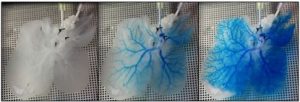
Per the United Network for Organ Sharing, every ten minutes, someone is added to the national transplant waiting list in need of a kidney, liver, pancreas, heart, lung, or intestine, the most needed organs of 2017. As of the end of January 2018, there were 114,883 people needing a lifesaving organ transplant (total waiting list candidates) with 74,722 of those people being active waiting list candidates. Tragically, on average, 20 people die each day while waiting for a transplant. More than 7,000 candidates died in 2016 while on the wait list, or within 30 days of leaving the list for personal or medical reasons, without receiving an organ transplant.
In the laboratory of McGowan Institute for Regenerative Medicine deputy director, Stephen Badylak, DVM, PhD, MD, professor in the Department of Surgery and director of the Center for Pre-Clinical Tissue Engineering within the Institute, researchers are working to increase the shortage of viable, transplantable livers by engineering a functional whole organ for treatment of end stage liver disease. Dr. Badylak and his team are aggressively investigating a therapeutic whole organ replacement strategy that is based upon the concept that functional hepatic tissue can be engineered by the effective delivery of autologous hepatic parenchymal and non-parenchymal cells within a xenogeneic 3-dimensional scaffold composed of liver extracellular matrix (3D L-ECM). This approach would include immediate in-situ transplantation of the cell seeded scaffold, providing the requisite perfusion by the host circulation that supplies appropriate microenvironmental cues, nutrients, and signaling factors necessary for liver regeneration.
By decellularizing the entire organ, most of the 3D structure of the extracellular matrix (ECM) can be retained to provide a native framework for organ reconstruction. The long-term goal of this work is to establish the decellularization, recellularization, and transplantation criteria necessary to produce a fully functional bioengineered liver for organ transplantation and drug discovery.
As Dr. Badylak explained to reporter Patrick J. Kiger, HowStuffWorks, “Success by this method means that the recipients would no longer be relegated to immunosuppressant therapy and would not have to wait for a matched donor organ.”
According to Dr. Badylak, more than a dozen scientific teams around the world are working to develop the ability to grow transplant organs from stem cells, in addition to other researchers who are working on the problem on a smaller scale. The most promising approach is decellularization, a technique in which the cells are stripped from a donor organ — usually one from a pig — leaving behind a tissue scaffold upon which the organ can be rebuilt by using stem cells, he says.
Illustration: Snapshots of blue dye flowing through the vasculature of a 3D rat liver ECM scaffold. Badylak Laboratory.
Read more…
